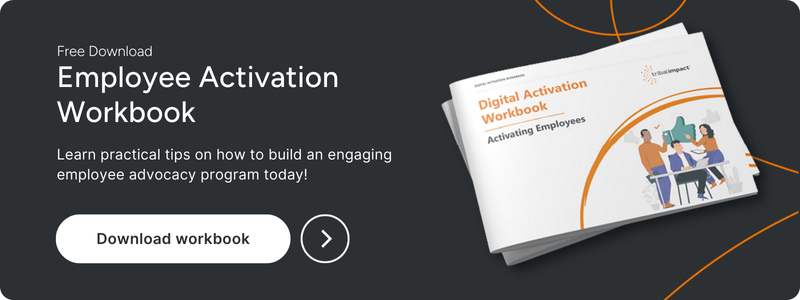‘An organisation lives and dies by its reputation’ explained Charu Malhotra in a LinkedIn Live with Sarah Goodall.
Charu has led employer branding, talent branding, and recruitment marketing for brands including Primark, Unilever, and McKinsey. So, she knows her stuff.
In this interview, we explore how employee voices can impact employer branding. Listen to the conversation on our podcast below, or read on for a full summary in this blog.
Why does Employee Advocacy Matter to Employer Branding?
Charu opened by explaining that employer branding is the promotion of an organisation’s brand and its reputation, managed and nurtured through HR and marketing.Employer branding now covers employees, ex-employees, and even customers. These can all be strong advocates or detractors. Part of Charu’s job is to be cognizant of both.
According to LinkedIn, 75% of job seekers consider an employer’s brand before applying for a job.
Who Should Take Ownership of Employee Voices?
Charu has worked in a lot of places, and it was different every time. She’s found that the accountability differs depending on which department she sits under.
If it were up to her, employer branding would sit with the director of marketing and shared with talent acquisition. This is because it’s a shared responsibility that’s as much about internal marketing as it is about external advocacy and communications.
Recently, she’s noticed a shift – marketing is now seen as a close ally of employer branding.
She’s also found that when L&D and talent mobility teams get involved, it leads to richer content.
The Difference Between Customer Experience and Candidate Experience
Charu sees them as linked but explained that a customer choice or decision is transactional.
Moving jobs is a huge life experience. That’s why candidate experience is so important.
As recruiters, it’s easy to lose sight of that because for companies it’s all about filling the job.
But moving jobs can be an emotional decision – Charu has turned down roles based on gut feelings before.
She also referenced a video by Katrina Kibben. It talks about why candidates need emotional safety when it comes to job moves and why businesses should take it more seriously.
What’s the Connection Between Employee Voices and Employer Branding?
A lot of the time, employees share job ads and that’s it. Charu feels strongly that that’s the least a hiring manager and their team can do.‘Ultimately, if you’re sharing a role, talk about it. If you’re really time poor, share the two best things about this role. But don’t just share it in isolation,’ said Charu.
If each person shares a different thing about the same job, it’s a lot more interesting for people who follow multiple employees within the same organisation.
Many brands position themselves as the hero, starting a job ad with several paragraphs about how great the business is before explaining what the role is and what it means for candidates. This loses sight of the fact that candidates want to be the hero/heroine of the story.
Sarah suggested a hiring manager could create a video to help candidates get to meet the person they’ll be working with as an alternative.
How to Support Employees Content Creation
Charu believes there’s a time and place for big-budget videos filmed in a studio, but there’s also space for videos filmed quickly on a phone.Employees also need the confidence to share, which is why a lot of her role involves coaching and providing guardrails. Giving employees a framework helps.
Some employees will be more comfortable creating videos, while others will prefer to write content. Helping them find what works for them and encouraging content diversity is key.
Sarah also mentioned that internal social media tools can be a safe zone for employees to hone their skills. This content can then be shortlisted to share as external content, if that’s ok with the employee who created it.
How AI Helps with Talent Recruitment
According to Tidio, 89% of people think AI could help candidates with job applications.
Charu has seen businesses say they’ll use AI in the hiring process but they don’t want candidates to.
But how can you stop them?
If a business uses AI in hiring, it seems unfair to expect candidates not to and penalise them for using it.
She believes AI is great from an efficiency point of view. It reduces some administrative tasks. For example, it’s quicker for talent acquisition teams to sift out repeat job applicants using AI.
AI can also analyse interviews and tag what people have said, helping to map people to the right roles at the right time. It’s better for candidates and businesses – 68% of recruiters feel that AI will remove unintentional bias in the recruitment process.
How to Attract and Retain Diverse Employees
Charu says that she sees people say diversity isn’t important and it fills her with disbelief. Representation matters.
It’s about thinking with an employee voice lens, sharing interesting content, and not making stuff up that you think is important.
So many companies spend time and money going for awards. That holds more weight in some countries than others.
But it’s more important to ask employees what they want to share.
If you want to attract people from diverse groups, ask them what would be valuable, interesting, and compelling. Diversity doesn’t work if it’s forced.
Nobody wants to work with a company that talks about having an inclusive culture on their career site, but then when they join the business hasn’t thought about how to retain diverse employees.
‘Diversity is only empowered by employee voices’ Charu explained.
It’s easy to sense when something has been scripted compared to when someone shares details of a job they genuinely enjoy and why they’d recommend it.
Businesses should also be mindful of over-featuring the one or two diverse employees it has. There can be a tendency to overuse them in companies that struggle with diversity.
This can be tiring for those individuals and doesn’t help the employer brand. It’s more effective to share what you plan to do to get to a better place. Candidates can then see what’s going on behind the scenes, something which is useful and interesting to them.
Employee Voices Are Powerful
Employee voices can be powerful tools to develop relationships between brands, prospects, and candidates.
To get them onboard, businesses need to encourage employees to find a medium that works for them, such as video or blogs.
They also need to ensure that content feels original to that person and not a generic blast everyone within a company shares to spread the word as far as possible. That won’t go as far as something that’s tailored to an employee’s network.
If you’d like help bringing your employee voices to life, get in touch today.

